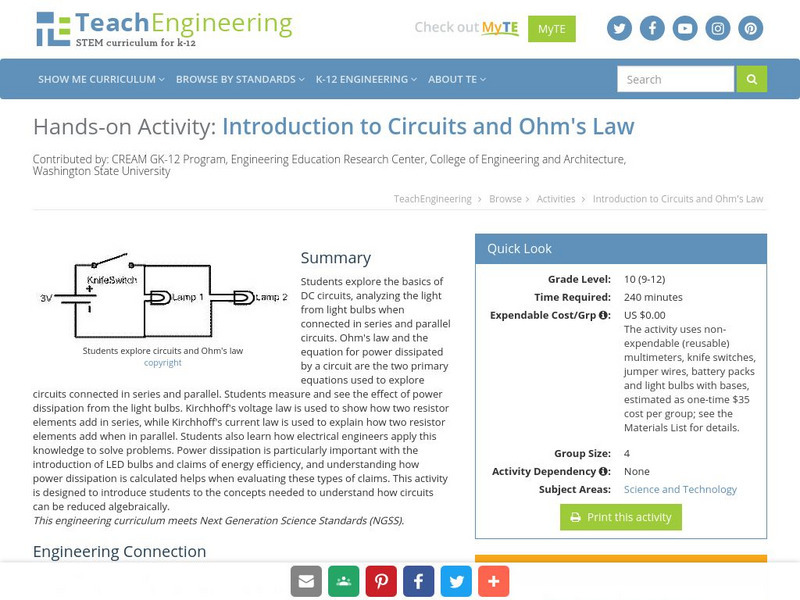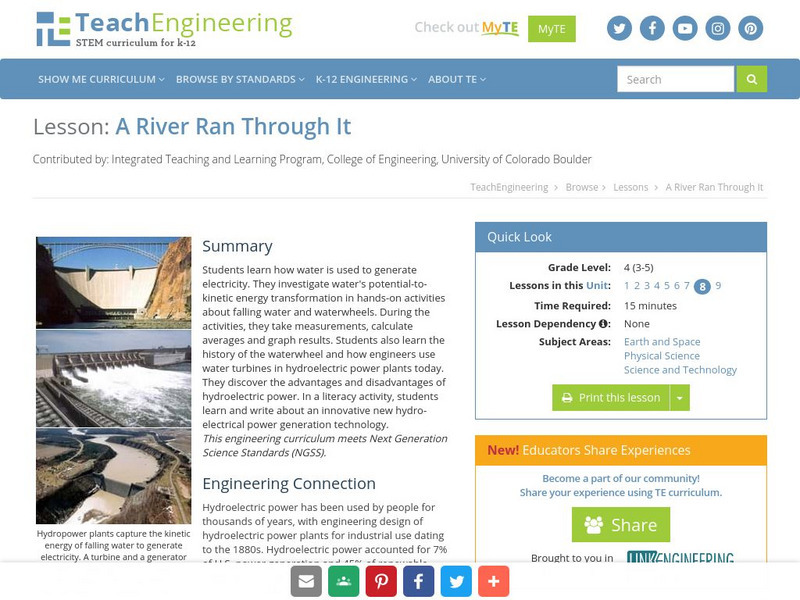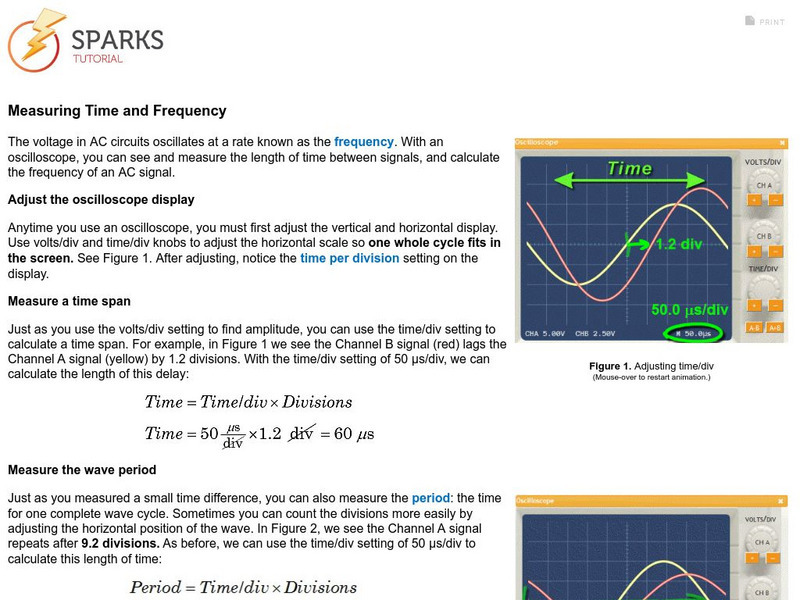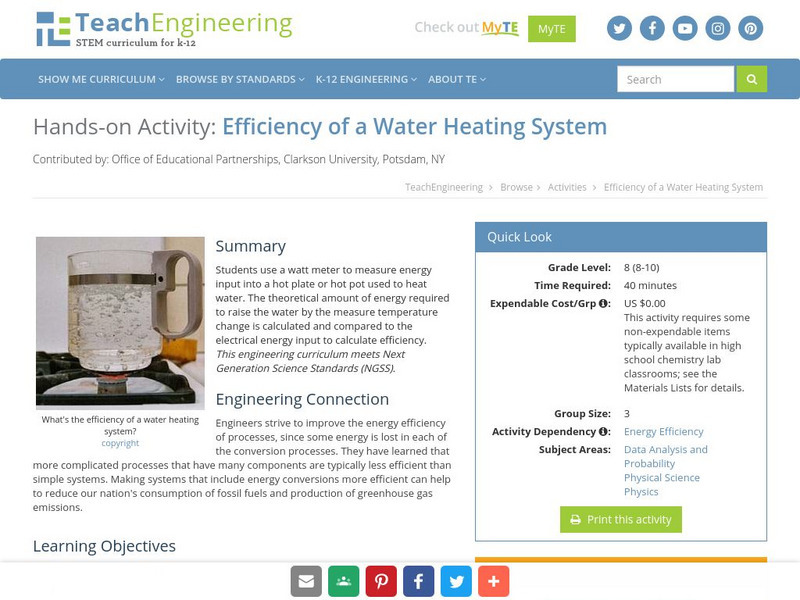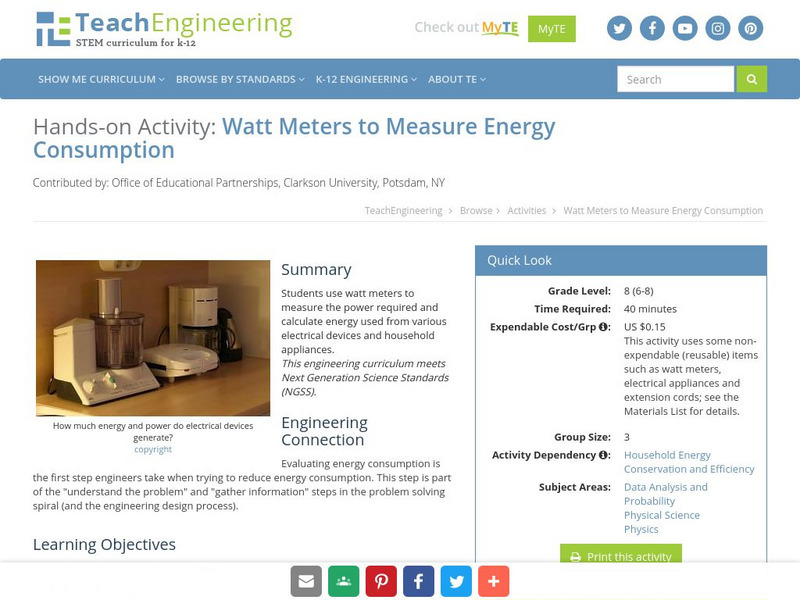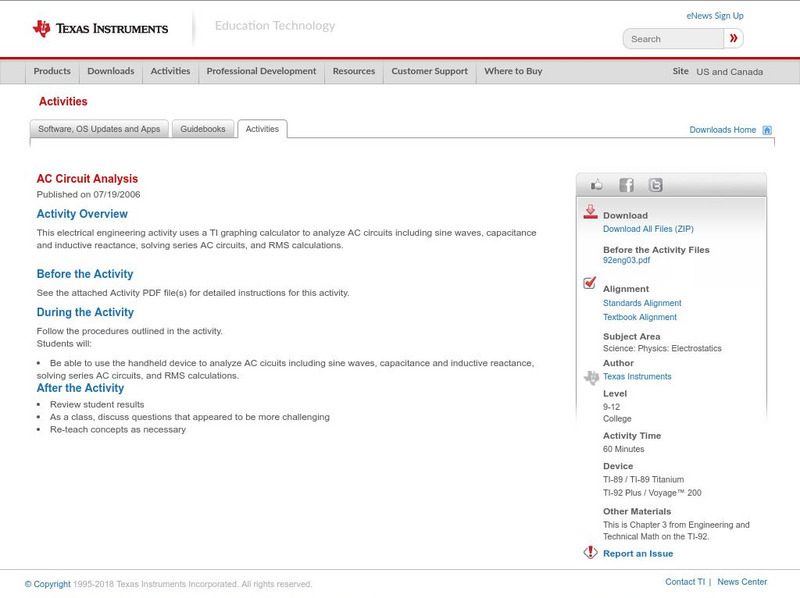Hi, what do you want to do?
TeachEngineering
Teach Engineering: Introduction to Circuits and Ohm's Law
Students will explore the basics of dc circuits analyzing the light from light bulbs when connected in series and parallel circuits. Ohm's Law and the equation for power dissipated by a circuit will be the primary equations used. Using...
TeachEngineering
Teach Engineering: Renewable Energy Living Lab: The Bright Idea
Students use real-world data to evaluate the feasibility of solar energy and other renewable energy sources in different U.S. locations. Working in small groups, students act as engineers evaluating the suitability of installing solar...
TeachEngineering
Teach Engineering: Renewable Energy Living Lab: Power Your School
Students use real-world data to calculate the potential for solar and wind energy generation at their school location. After examining maps and analyzing data from the online Renewable Energy Living Lab, they write recommendations as to...
Science Struck
Science Struck: Horsepower Formula
Explains what is meant by horsepower, where the term originated, and demonstrates how to use the formulas for calculating the horsepower of a car and an electric motor. Conversion formulas are also provided. Includes interactive...
Cosmo Learning
Cosmo Learning: Gauss's Law
A collection of video lectures about Gauss's Law taught at East Los Angeles College The course teaches about the alternative method to calculate the electric field with explanations and examples. Site includes fourteen lectures that vary...
TeachEngineering
Teach Engineering: A River Ran Through It
Young scholars learn how water is used to generate electricity. They investigate water's potential-to-kinetic energy transformation in hands-on activities about falling water and waterwheels. During the activities, they take...
Science Struck
Science Struck: Potential Energy Formula
Explains what is meant by potential energy and demonstrates how to use the formulas for gravitational potential energy, elastic potential energy, and electric potential energy. Includes interactive calculators for the first two formula...
Other
Big Ceramic Store: Ceramic Tips
This site provides a series of seventy-four tips on ceramics. The tips range anywhere from using resists and recycling clay to decorating with oxides and calculating the cost of firing on electric kiln.
Concord Consortium
Concord Consortium: Measuring Time and Frequency
The voltage in AC circuits oscillates at a rate known as the frequency. With an oscilloscope, see and measure the length of time between signals, and calculate the frequency of an AC signal.
Concord Consortium
Concord Consortium: Dc Circuits: Series Parallel Resistances (Sparks 3)
Answer questions regarding voltage drops across resistors and currents through them in such circuits. Practice calculating the effective resistances of a set of resistances in series and parallel.
CK-12 Foundation
Ck 12: Chemistry Simulation: Battery
[Free Registration/Login Required] Explore how batteries use redox reactions to create electrical energy to power a flashlight.
Other
Ask Numbers: Measurement Conversion Calculators and Charts
What kind of unit conversion would you like to do? This site will allow you to do a multitude of conversions. Just click on the specific measurement you are needing to convert. It also provides a history of measurements and a chart of...
Texas Instruments
Texas Instruments: Lemon "Juice"
"Juice" is a slang term sometimes used for electricity. Batteries are made up of one or more cells. Cells often consist of two different materials in a solution that are connected to each other by a wire. In this experiment, you will...
TeachEngineering
Teach Engineering: Efficiency of a Water Heating System
Students use a watt meter to measure energy input into a hot plate or hot pot used to heat water. The theoretical amount of energy required to raise the water by the measure temperature change is calculated and compared to the electrical...
Climate Literacy
Clean: Compact Fluorescent Light Bulbs Cost Benefit Analysis
This analysis activity allows students to calculate electrical usage in home lighting, and create a cost-benefit analysis for cost and energy savings by replacement of incandescent light bulbs with compact fluorescent or LED light bulbs.
TeachEngineering
Teach Engineering: Watt Meters to Measure Energy Consumption
Students use watt meters to measure the power required and calculate energy used from various electrical devices and household appliances.
TeachEngineering
Teach Engineering: Household Energy Conservation and Efficiency
Middle schoolers complete three different activities to evaluate the energy consumption in a household and explore potential ways to reduce that consumption. The focus is on conservation and energy efficient electrical devices and...
Texas Education Agency
Texas Gateway: Second Law of Thermodynamics: Heat Engines and Their Efficiency
By the end of this section, you will be able to state the expressions of the second law of thermodynamics; calculate the efficiency and carbon dioxide emission of a coal-fired electricity plant, using second law characteristics; and...
State Energy Conservation Office-Texas
State Energy Conservation Office: Feasibility of Photovoltaic Systems [Pdf]
Summarizes how a photovoltaic or PV system works to convert solar energy into electricity. Explains how to estimate what size of PV system is needed and what the cost would be, and provides a worksheet with formulas for calculating...
US Department of Energy
U.s. Department of Energy: Energy Savers
Find information on everything from buying energy-efficient products to using the proper landscaping for particular climates to conserve resources. Starting with an energy assessment, this website will help users reduce their consumption...
Texas Instruments
Texas Instruments: Ac Circuit Analysis
This electrical engineering activity uses a TI graphing calculator to analyze AC circuits including sine waves, capacitance and inductive reactance, solving series AC circuits, and RMS calculations.
Physics Aviary
Physics Aviary: Capacitor Properties Lab
This lab is designed to have students investigate the different changes that could be made to an air filled capacitor and the results that occur because of these changes. Students can vary the gap between the plates, the size of the...





